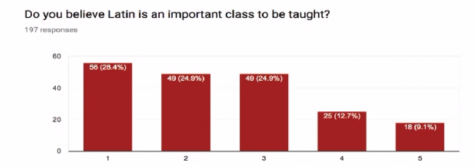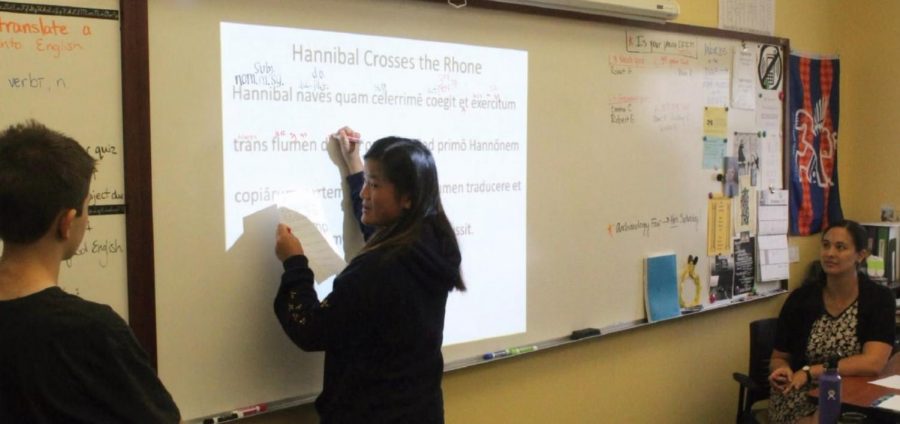Students question the Classics at WHHS
Two students work to diagram and deconstruct a Latin sentence with the guidance of Kathleen Keener. Latin, a fundamental part of the WHHS curriculum, is sometimes criticized as unnecessary and outdated.
October 9, 2018
Many seventh graders coming into WHHS are instilled with a fear of Latin before they even step into a classroom. Skylee Paree, ‘24, attests to this, saying, “I thought it would be challenging, because I have a word association disorder, but it’s actually not as bad as people said.”
Students like Antwane Pope, ‘19, say, “My problem lies with that fact that Latin isn’t taught like most other languages at Walnut. I know it’s a dead language and all but I feel like it relies too much on memorization. I realized this when I took German and it was so much easier, that being said, I think Latin did help me understand some grammatical concepts more clearly, and it make German easier.”
According to a survey about Latin, which involved 200 WHHS students, 28.4 percent of students do not believe Latin is an important class to be taught with an additional 25 percent saying they’re neutral on the subject.
Many teachers claim that teaching Latin is what sets WHHS apart from other schools. According to usnews.com, WHHS is the number one school in Ohio and ranks as the ninety-sixth high school in the nation. A big part of its success is attributed to the school adhering to a “rigorous classical program,” according to the WHHS website.
The classical education is a traditional style method in which students are required to utilize rhetoric and logic to learn about the world around them. Additionally, many institutions that adopt a classical style teach Latin, and sometimes Greek, as part of their curriculum, according to classicalacademicpress.org.

Michelle Martinez, a Latin and Greek teacher, insists that both languages have a significant impact on students. She said, “Both languages build your vocabulary and help you prepare for standardized tests, especially Greek, which is useful for STEM [Science, Technology, Engineering, and Mathematics]. Also, it’s important to know that we’re not reading these languages just to read them, we’re learning about ancient history and culture, and that’s important,” Martinez said.
Another question in the survey asked students to answer how much of English vocabulary comes from Latin roots and words. More than 50 percent of participants answered that they think that under half of English vocabulary comes from Latin. According to dictionary.com, 80 percent of dictionary entries are borrowed from mainly Latin. This shows why many believe students underestimate the importance of Latin.
Latin teacher Kathleen Keener explains key concepts of Latin that students can struggle with. “I think the thing that really makes Latin different is the skill set required with Latin,” Keener said. “The goal with a modern foreign language class is to be able to communicate in a modern foreign language, and to learn a little culture as well, whereas the goal with Latin is to read ancient writing, with a heavier focus on grammar.”
Keener also added that a lot of the issues students have is that they do not have the prerequisite skills required for Latin, such as being able to memorize and a proper grasp of grammar as it applies to Latin. She also feels that the Latin program could do a better job by adjusting their expectations and teaching style to people who might not be as prepared for the standards of the WHHS curriculum in general, not just Latin.
Martinez tries to make Latin and Greek more understandable for her students. “It’s important that both of these languages don’t just exist in a vacuum, we’re reading [Latin] so we learn more about ancient cultures and civilizations, and maybe that way we’re able to keep students more engaged while also sticking to the principles of a classical education,” Martinez said.
As shown in survey results and teacher’s opinions, students appear unaware of the importance of Latin. Teachers such as Martinez and Keener believe that teaching more efficiently will raise enthusiasm and thus boost learning.




![Freshman choir students practice in class. “[The class] is almost like an army working together,” Anthony Nims, choir director, said.](https://whhscbox.com/wp-content/uploads/2025/10/freshman-choir.png)
![New theater teacher Mr. Mitchell leads his Stagecraft students through hands-on set-building techniques. “For me, [teaching] comes from the joy of learning, which is why I wanted to be in an educational setting.”](https://whhscbox.com/wp-content/uploads/2025/10/IMG_3248-901x1200.jpeg)

